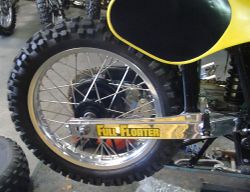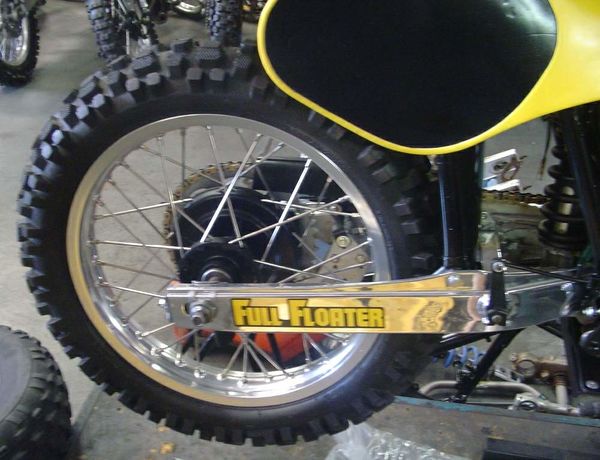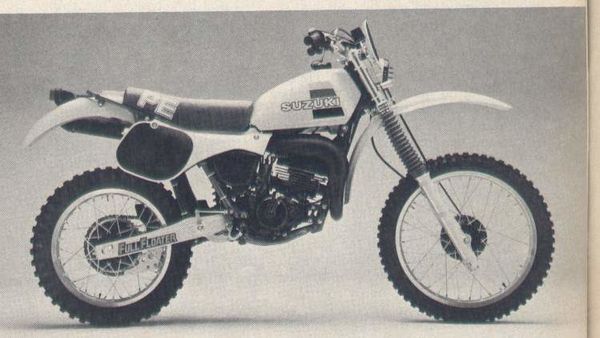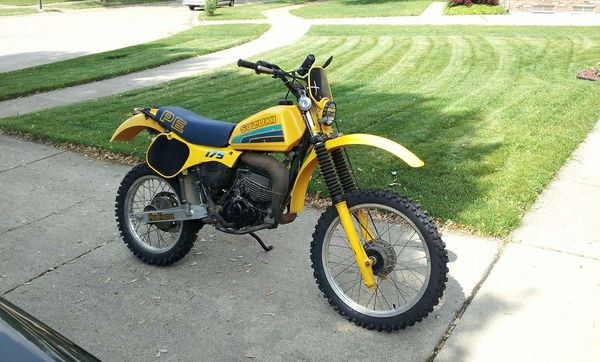Suzuki PE175E
 |
|
| Suzuki PE175E | |
| Manufacturer | |
|---|---|
| Production | 1983 - 84 |
| Engine | Two stroke, single cylinder, piston and reed valve |
| Compression ratio | 7.9:1 |
| Ignition | Suzuki PEI |
| Spark Plug | NGK B10EGV, Champion N-59G |
| Transmission | 6 Speed |
| Frame | Single-downtube, dual-cradle frame; box-section aluminum swing arm |
| Suspension | Front: Leading-axle air-assisted fork with 38mm tubes Rear: Gas-charged remote-reservoir mono-shock absorber, adjustable for spring preload and rebound damping |
| Brakes | Front: Drum, internal expanding Rear: Drum, internal expanding |
| Front Tire | 3.00-21 4PR |
| Rear Tire | 4.00-18 4PR |
| Wheelbase | 1448 mm / 57.0 in |
| Weight | |
| Recommended Oil | Suzuki ECSTAR 10w40 |
| Fuel Capacity | 12 Liters / 3.2 US gal / 2.6 Imp gal |
| Manuals | Service Manual |
Engine[edit | edit source]
The engine was a Air cooled cooled Two stroke, single cylinder, piston and reed valve. The engine featured a 7.9:1 compression ratio.
Drive[edit | edit source]
Power was moderated via the Wet, multiplate.
Chassis[edit | edit source]
It came with a 3.00-21 4PR front tire and a 4.00-18 4PR rear tire. Stopping was achieved via Drum, internal expanding in the front and a Drum, internal expanding in the rear. The front suspension was a Leading-axle air-assisted fork with 38mm tubes while the rear was equipped with a Gas-charged remote-reservoir mono-shock absorber, adjustable for spring preload and rebound damping. The PE175E was fitted with a 12 Liters / 3.2 US gal / 2.6 Imp gal fuel tank. The wheelbase was 1448 mm / 57.0 in long.
Photos[edit | edit source]
Overview[edit | edit source]
Suzuki PE 175E
Two out of five of the main manufacturers of enduro bikes have dropped their 250s, leaving their 175/200s in the spotlight. The PE175E is one of those, ready for your scrutiny. If you picture technological progress as a race, it's safe to say Suzuki got the holeshot into the '80s with its off-road bikes. Suzuki started with fundamentally sound designs and then stuffed the competition with blockbusters like the Full Floater rising-rate suspension system. The original versions of the PE175 benefited directly from Suzuki's success in the early '80s. The twin-shock PE was a good bikewith the right kind of power, if not exactly enough of it, and stable and precise handling. The Full Floater PE, introduced in '82, was even better. Competing against the Can-Am,' Kawasaki, Honda and Yamaha, the PE struck a fine compromise between tractable power (like the Honda's) and screaming top-end power (like the Can-Am's and Yamaha's). So why the history lesson? Simple. The PE175E is stuck in 1982. It's virtually unchanged from the Z-model, while the other manufacturers are moving right ahead with the calendar. After a year-long hiatus, Can-Am is back with a completely redesigned single-shocker. Kawasaki bumped the KDX to 200cc last year, and Yamaha did the same this year. Honda finally sloughed its old two-valve engine and bolted an RFVC powerplant onto the XR chassis. The competition is on the move. In contrast, Suzuki has, since '82, refined the PE's gearing. The E-model has a lower final-drive ratio, higher first and third gears, and slightly different second, fourth, fifth and sixth gears. The net result is to lower first and third slightly, and essentially maintain the overall ratios of the rest. That's about it for refinement other than cosmetic changesa blue frame and fork boots, yellow fork tube protectors, new tank graphics and a gold handlebar. Nevertheless, thanks to several solid basic qualities, the PE is still competitive for many riders in particular applications. The engine, for example, has nice smooth power characteristics. With fairly heavy flywheels it gains revs slowly, avoiding bursts of power. Consequently, on tight trails that call for some finesse, the PE excels, especially for novices and intermediates. Less-than-expert riders may find, too, that the Suzuki cranks out quite enough power for wide-open crosscountry riding. It's true that even back in '82 the PE's chief two-stroke competitors developed more mid-range and top-end power than the 175, and with their redesigns that gap has widened. But despite the numbers the PE is no slouch. Although trying to wring out the final pony may frustrate top-rank experts, most riders will find they can usually ride the Suzuki as fast as their own ability allows. Credit for the quality of the powerband and soundness of design goes to the factory's effort developing world-class motocross machinery, and to the defunct Team Suzuki's experience applying that technology to the enduro bikes. The latest-generation powerplant, for example, uses the same porting layout (six transfers, a bridged intake and exhaust) and the same reed-valve induction design as the RM motocrossers. The PE, however, boasts carefully altered port timing and exhaust tuning that suit the powerband to woods work. Although the development is still paying off, it can't make up for the competition's extra 25 cubic centimeters or a year or two of careful refinement. This year the PE's long suit, consequently, is its handling. In this regard, enduro bikes are penalized less than motocrossers for lagging behind technologically. Though the running gear is unchanged, Suzuki's engineers developed a good package the first time around. The full-cradle frame hooks to a box-section aluminum swing arm and produces straightforward geometry. With a 57-inch wheelbase, a 28-degree rake and 4.5 inches of trail, the PE reacts to steering input a trifle slow; on the other hand, it feels stable even when your technique is a little sloppy. In any case, there's some latitude to raise the fork tubes in the triple clamps, so you can experiment with the geometry and quicken the steering if you want. Since enduro riders value a low seat height, manufacturers have in general avoided super-long-travel suspension. As a result, the PE's 10.6 inches of travel front and rear is right in the ballpark. Up front the air-assisted fork reacts well to bumps of all sizes, and the damping complements the springing nicely. With four-way adjustable rebound damping, the rear shock too performs well for 170-pound ridersresisting bottoming, reacting fluidly to stutter bumps and offering enough compression damping to aid springing. In respect to its overall weight, the PE is showing its age. Yamaha's IT has long held a 14-pound advantage over the Suzuki, and Kawasaki cut a sizable amount during last year's redesign of the KDXit weighs in 17 pounds lighter than the Suzuki. You really feel the PE's extra pounds on tight trails when you have to flick the bike side to side quickly. There, the Suzuki is more difficult than the KDX or IT to snap around with body English. Furthermore, the more aggressively you ride, the more you'll notice the front brake's limited power and feel. If you ease on the brake, it helps stop the bike pretty well, but there's no point at which you can modulate any serious power. Experts intent on competing should study the variety of machinery available in the hotly competitive 175/200cc class. Though no company has made any startling breakthroughs in development, refinement has yielded definite, if small, resultsand a minor advantage is all an expert needs to win. The flip side is that the Suzuki is still a good bike for less-than-serious enduroists and most definitely a fine machine for Sunday play riders. It has good power, precise and stable handling, and proven reliabilityqualities always at a premium.
| Make Model | Suzuki PE 175 |
|---|---|
| Year | 1983 - 84 |
| Engine Type | Two stroke, single cylinder, piston and reed valve |
| Displacement | 172 cc / 10.7 cu in |
| Bore X Stroke | 62 x 57 mm |
| Compression | 7.9:1 |
| Cooling System | Air cooled |
| Lubrication System | Fuel/oil premix, 20:1 |
| Induction | Mikuni VM34SS carburetor |
| Ignition | Suzuki PEI |
| Spark Plug | NGK B10EGV, Champion N-59G |
| Starting | Kick |
| Max Power | 18 kW / 24 hp @ 9500 rpm |
| Max Torque | 18.5 Nm / 1.9 kgf-m / 13.7 lb-ft @ 7500 rpm |
| Clutch | Wet, multiplate |
| Transmission | 6 Speed |
| Final Drive | Chain, DAIDO DID 520UB, 106 links |
| Primary Reduction | 2.761 (58/21) |
| Final Reduction | 4.000 (48/12) |
| Gear Ratios | 1st 3.00 (33/11) / 2nd 2.142 (30/14) / 3rd 1.647 (28/17) / 4th 1.300 (26/20) / 5th 1.045 (23/22) / 6th 0.875 (21/24) |
| Frame | Single-downtube, dual-cradle frame; box-section aluminum swing arm |
| Front Suspension | Leading-axle air-assisted fork with 38mm tubes |
| Front Wheel Travel | 270 mm / 10.7 in |
| Rear Suspension | Gas-charged remote-reservoir mono-shock absorber, adjustable for spring preload and rebound damping |
| Rear Wheel Travel | 270 mm / 10.6 in |
| Front Brakes | Drum, internal expanding |
| Rear Brakes | Drum, internal expanding |
| Front Tire | 3.00-21 4PR |
| Rear Tire | 4.00-18 4PR |
| Rake | 28o |
| Trail | 113 mm / 4.45 in |
| Steering Angle | 45o (left & right) |
| Turning Radius | 2.3 m / 7.5 ft |
| Dimensions | Length: 2100 mm / 82.7in Width: 880 mm / 34.6 in Height: 1200 mm / 47.2 in |
| Wheelbase | 1448 mm / 57.0 in |
| Ground Clearance | 280 mm / 11.0 in |
| Dry-weight | 106.7 kg / 234.5 lbs |
| Transmission Oil Capacity | 0.8 Liters / 0.85 US qt / 0.7 Imp qt |
| Fuel Capacity | 12 Liters / 3.2 US gal / 2.6 Imp gal |


